Learning Class 11 Psychology
Nature of Learning
Learning can be described as a "long-lasting modification in behaviour or potential behaviour that is the result of an individual's experiences."
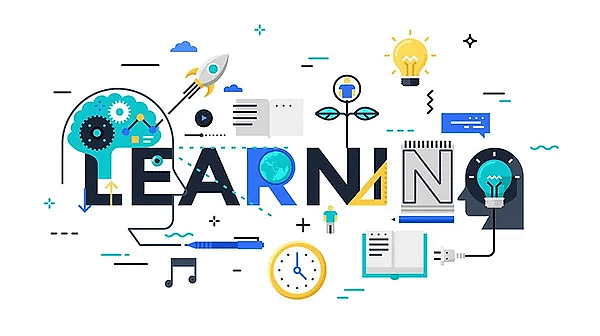
Learning shows up as lasting changes in how someone acts or could act, caused by practice and experience.
Features of learning
The process of learning has specific characteristics such as :
- Learning in psychology always involves experiences.
This means we go through events in a particular order repeatedly. For instance, one learns that if the bell rings in the hostel after sunset, dinner is ready. Repeatedly feeling satisfied after doing something a certain way builds a habit. A single incident can also lead to learning; for example, if a child burns their fingers when striking a match, they learn to be careful with matches in the future. - Changes in behaviour due to learning are relatively permanent.
It's important to differentiate these changes from temporary ones caused by fatigue, habituation, or drugs. For example, if you study psychology for a while or practise driving, you will eventually feel tired and stop. This change is due to fatigue and is not considered learning. - Learning includes a sequence of psychological events.
If psychologists want to understand how a list of words is learned, they follow a specific sequence: (i) conduct a pre-test to measure initial knowledge, (ii) present the word list to memorise for a certain time, (iii) process the word list to gain new knowledge, (iv) learn the new information after processing, and (v) recall the information later. Comparing the individual’s knowledge before and after learning shows that learning has occurred, which is separate from performance.
Paradigms of learning
- Different methods are used to learn simple responses compared to complex ones.
- The simplest kind of learning is called conditioning.
Types of conditioning
- Classical Conditioning: This learning method was first studied by Ivan P. Pavlov. It involves connecting a neutral stimulus with an important one to trigger a response. In this process, an organism learns to associate different stimuli.
- Instrumental/Operant Conditioning: Learning through rewards and punishments that either encourage or discourage behaviours.
- Observational Learning: Learning by observing and mimicking the actions of others.
- Cognitive Learning: Involves mental processes like thinking, remembering, and problem-solving.
- Verbal Learning: Acquiring knowledge through language and communication.
- Skill Learning: Developing physical or mental skills through practice and repetition.
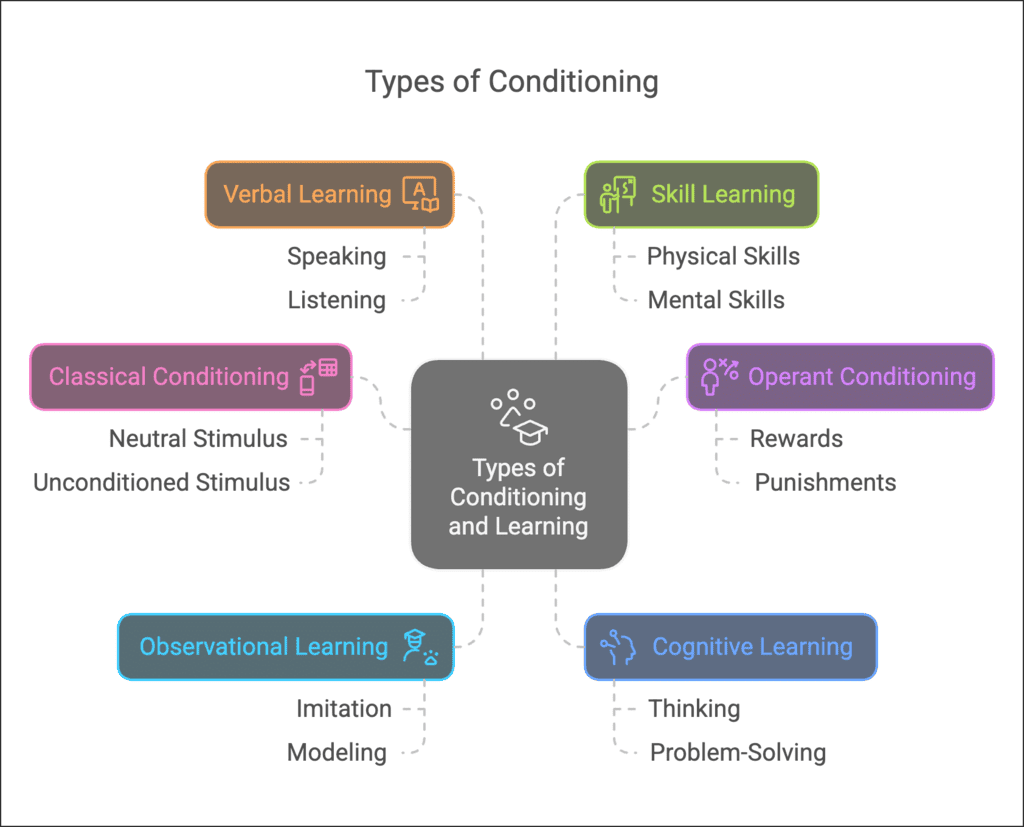
Classical Conditioning
- A neutral stimulus (CS) that indicates an unconditioned stimulus (UCS) starts to elicit a response (CR) that prepares the organism for the US. Pavlov first explored classical conditioning while studying digestion in dogs.
- Classical conditioning relies on the timing relationship between a neutral stimulus and an already elicited response. The CS becomes a predictor of the UCS, transforming the neutral stimulus into a conditioned stimulus that triggers a conditioned response.
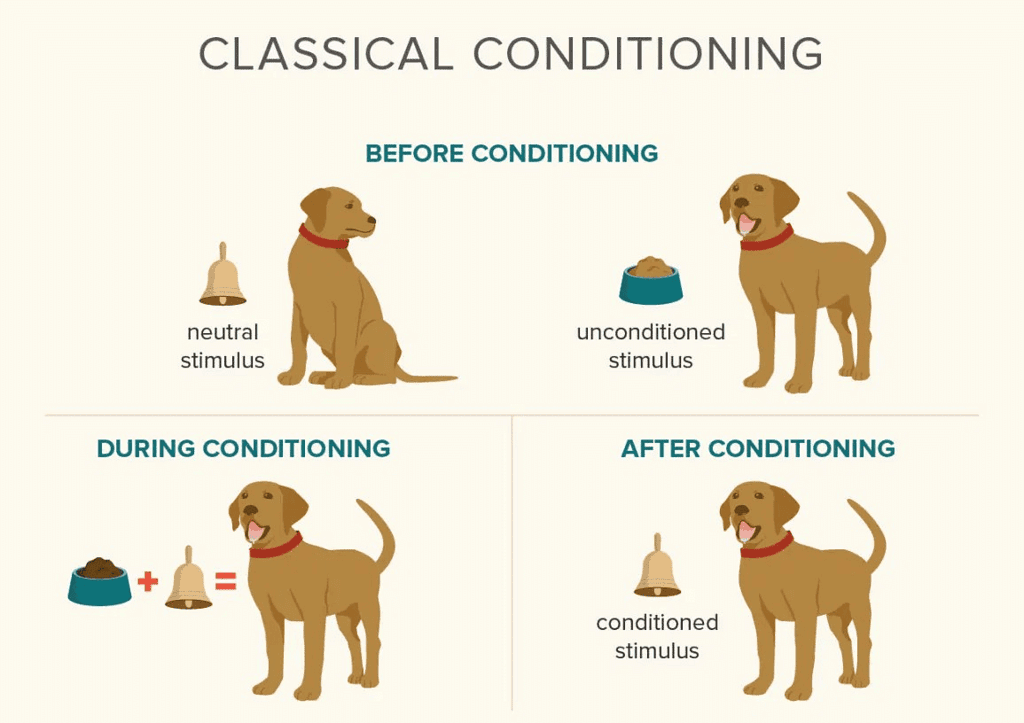
Determinants of Classical Conditioning
The speed and strength of learning a conditioned response in classical conditioning depend on various factors.
Types of Conditioning Procedures
The procedures used in classical conditioning can be classified into four types based on when the conditioned stimulus (CS) and unconditioned stimulus (US) occur. The first three are known as forward conditioning, while the last is referred to as backwards conditioning. The basic arrangements are as follows:
- Simultaneous Conditioning: CS and US occur at the same time.
- Delayed Conditioning: CS is presented before the US, with some overlap. This method is the most effective for developing a CR.
- Trace Conditioning: CS is shown before the US, but there is a break in between. Both simultaneous and trace conditioning can lead to a CR, but they typically require more trials than delayed conditioning.
- Backwards Conditioning: US appears before CS. It is important to note that acquiring a response through this method is quite rare.
Type of Unconditioned Stimuli
- Appetitive: Unconditioned stimuli in classical conditioning can be divided into two types: appetitive and aversive. Appetitive stimuli trigger approach behaviours, such as eating, drinking, or hugging, which provide satisfaction and joy.
- Aversive: Aversive stimuli, like loud noises, bitter flavours, electric shocks, or painful injections, are unpleasant and lead to avoidance or escape behaviours. Research shows that appetitive conditioning takes longer and needs more trials to learn, while aversive conditioning can be established in just one to three trials, depending on how strong the aversive stimulus is.
Intensity of Conditioned Stimuli
The strength of the CS affects both appetitive and aversive classical conditioning. More intense CS are more effective in speeding up the learning of conditioned responses, meaning that stronger stimuli need fewer trials for conditioning.
Operant/Instrumental Conditioning
Operant conditioning is a form of learning where the results of behaviour affect the chances of that behaviour happening again. Positive reinforcement boosts the likelihood of a response by providing a rewarding outcome. Rewards can meet various needs, including food, water, praise, money, and information. There are two types of reinforcers: primary reinforcers, which are naturally satisfying, and secondary reinforcers, which are learned through classical conditioning. Negative reinforcement involves the removal of unpleasant stimuli and encouraging behaviours that help avoid or escape discomfort. The four reinforcement schedules—fixed ratio, variable ratio, fixed interval, and variable interval—create different behaviour patterns.
Shaping and Punishment
Shaping is the process of reinforcing behaviours that gradually resemble the desired behaviour. Punishment is aimed at reducing a behaviour by introducing an unpleasant outcome. Another important aspect of this learning type is the nature of the behaviour being conditioned. The duration between the behaviour and the reinforcement also plays a role in operant learning.
Skinner Box
B.F. Skinner carried out experiments on operant conditioning using rats and pigeons in specially designed setups called Skinner Boxes. He investigated how voluntary actions occur when an animal interacts with its environment, which he named "operants." Operants are behaviours that animals and humans perform of their own accord and can control. The process of conditioning these voluntary behaviours is known as operant conditioning.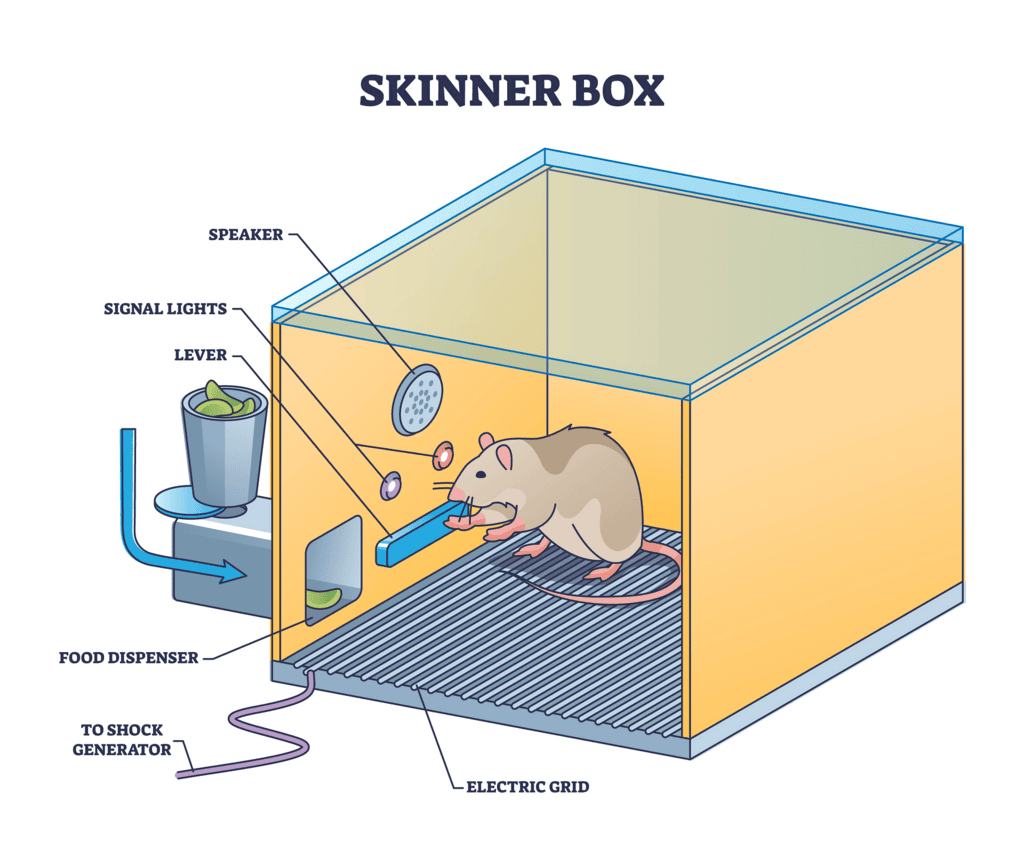
Skinner's Experiment
- A hungry rat is placed in a chamber where it can move but cannot escape.
- Inside the chamber, there is a lever linked to a food container above it.
- When the rat presses the lever, a food pellet falls onto a plate nearby.
- Initially, the rat accidentally presses the lever while exploring its surroundings and receives food.
- With repeated trials, the rat learns to press the lever more quickly to get food.
- Eventually, the rat presses the lever right after entering the chamber.
- Here, pressing the lever is the operant response, and getting food is the result.
This method of learning is also referred to as instrumental conditioning. We see examples of instrumental conditioning in daily life:
- Children who want sweets learn to find the jar where their mother hides them.
- Children learn to say 'please' to receive favours from their parents.
- People learn to use devices like radios and cameras based on instrumental conditioning principles.
- Overall, humans find shortcuts to achieve their desired outcomes through instrumental conditioning.
Determinants of Operant Conditioning
Operant conditioning, also known as instrumental conditioning, is a learning method where behaviour is shaped by its outcomes. These outcomes, called reinforcers, are events or stimuli that make a response more likely to happen. Reinforcers can vary in type, such as positive or negative, and can differ in frequency, quality, and schedule—whether they are given continuously or intermittently (partially).
Types of Reinforcement
- Positive reinforcement: This involves pleasant outcomes that encourage desired behaviours, like food, praise, or money. Positive reinforcers fulfil needs such as food, water, medals, status, and information.
- Negative reinforcement: This involves unpleasant stimuli. Responses that help to remove or avoid these painful stimuli provide negative reinforcement.
Number of Reinforcements and other Features: This refers to how many times an organism has been rewarded. The speed of operant conditioning usually increases as the frequency, amount, and quality of reinforcement rise. Additionally, the time gap between the response and the reinforcement also affects how operant learning takes place.
Schedules of Reinforcement
- Reinforcement schedules are crucial for learning.
- Continuous reinforcement happens when a desired action gets rewarded every time it happens. This type leads to a high response rate, but when rewards stop, the rate drops quickly, and learned behaviours can fade away.
- Partial reinforcement results in more persistent behaviours than continuous reinforcement. In this case, rewards are given sometimes and not at other times.
- Different reinforcement schedules affect how conditioning develops, and thus the responses show different traits.
Delayed Reinforcement
- The timing of rewards significantly influences their effectiveness. If rewards are delayed, performance tends to suffer.
- This can be demonstrated by asking children to choose between immediate small rewards and larger rewards given after a long wait. They usually prefer the smaller rewards right away.
Key Learning Processes
Classical vs. Operant Conditioning: The distinction lies in the control of responses by stimuli in classical conditioning and by the organism in operant conditioning.
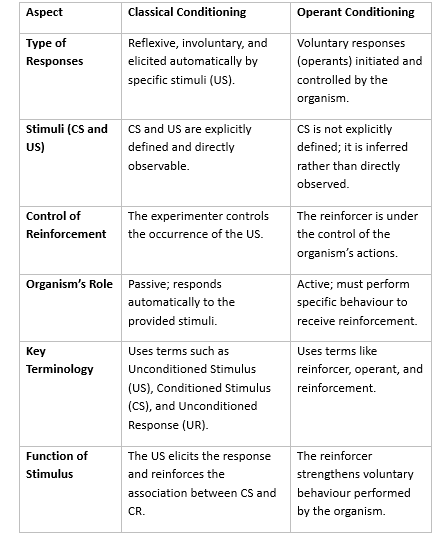
Learned Helplessness
- This is a situation where repeated failures lead to a lack of effort and poor performance, often associated with depression.
- It was shown by Seligman and Maier in experiments with dogs.
- Dogs that received unavoidable shocks stopped trying to escape even when they had the chance.
- This behaviour, termed learned helplessness, arises from past experiences of feeling unable to control situations.
Human Examples:
- Continuous failure in tasks leads to reduced persistence and poor performance.
- Demonstrated in experiments where participants fail repeatedly regardless of performance, leading to helplessness.
Significance:
- Explains psychological conditions like depression.
- Continuous failure can cause individuals to stop attempting solutions, even when conditions change.
Reinforcement
- This means applying a reinforcer to boost the likelihood of a response occurring.
- Reinforcers are stimuli that enhance the behaviour that follows them.
- Positive Reinforcement: This increases the response rate by introducing a pleasant stimulus after the behaviour.
- Negative Reinforcement: This boosts the response rate by removing an unpleasant stimulus after the behaviour.
- Reinforcers can be:
i) Primary Reinforcers: Essential for survival, like food for a hungry animal.
ii) Secondary Reinforcers: Gained through experience, such as money, praise, or marks. - Responses can be shaped by rewarding closer and closer attempts to the desired action.
- The timing of reinforcement greatly affects its effectiveness.
- For example, children often prefer smaller immediate rewards for completing chores over larger rewards given later.
Extinction
- Refers to the disappearance of a learned response when reinforcement is removed.
- In classical conditioning, the CS-CR bond weakens if the CS is not followed by the US.
- In operant conditioning, learned behaviour fades if the response is no longer followed by reinforcement (e.g., no food for lever pressing).
- Resistance to extinction depends on factors such as:
i) Number of reinforced trials during acquisition.
ii) Amount and frequency of reinforcement during learning. - Key Insights:
i) Continuous reinforcement leads to lower resistance to extinction.
ii)Partial or intermittent reinforcement increases resistance to extinction.
Generalisation and Discrimination
Generalisation:
- Refers to responding similarly to stimuli that resemble the conditioned stimulus.
- Example 1: An organism conditioned to respond to a specific bell sound may respond to a similar tone.
- Example 2: A child learns to locate a sweets jar and generalizes this ability to find jars of different shapes and locations.
Discrimination:
- Involves telling apart similar stimuli and responding only to the specific one.
- Example: A child trained to fear a person with a moustache and in black clothes does not fear a clean-shaven person in grey clothes.
- Generalisation happens because of similarity, while discrimination comes from recognising differences.
Spontaneous Recovery
- Occurs when a learned response returns after being extinguished and after some time has passed.
- Example: After extinction, showing the conditioned stimulus again may lead to a reappearance of the conditioned response.
- This shows that extinction does not completely erase the learned response.
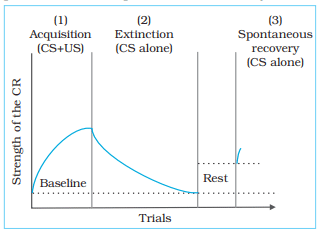
Observational Learning
- Previously referred to as imitation.
- Studied by Albert Bandura and his colleagues.
- Also known as social learning or modeling.
- Observers learn by watching the behaviour of the model, but their performance depends on whether the model's behaviour is rewarded or punished.
- Children often learn behaviours by watching and imitating adults.
Observational learning is a process where individuals learn by watching and imitating others. This type of learning is common in everyday life and can be seen in various situations, such as in fashion, social settings, and even in experimental studies.
Examples of Observational Learning
- Fashion Industry: Fashion designers often use tall, attractive models to promote their clothing. People see these models on television or in magazines and then imitate their style.
- Social Situations: People tend to observe and emulate the behaviour of their superiors or individuals they admire when faced with a new social situation.
Bandura's Study on Observational Learning
- Experiment Overview: Psychologist Albert Bandura conducted a famous experiment to study observational learning. He showed a five-minute film to children, depicting a boy acting aggressively towards a Bobo doll and other toys.
- Film Versions:The film had three versions:
- In the first version, children saw the boy being rewarded for his aggressive behaviour.
- In the second version, the boy was punished for his actions.
- The third version showed the boy without any reward or punishment.
- Observing Children's Behaviour: After watching the film, children were placed in a room with similar toys and their behaviour was observed.
- Findings:
- Children who saw the boy being rewarded for aggression were the most aggressive in their play.
- Those who saw the boy being punished were the least aggressive.
- Conclusion: The study concluded that observational learning involves acquiring knowledge by watching a model's behaviour, but how that behaviour is expressed depends on whether the model is rewarded or punished.
Children's Imitation of Adults
- Play and Games: Young children often imitate adult behaviours they observe in real life, on television, or in books during their playtime. For example, they might play pretend games like marriage ceremonies, birthday parties, or roles like thief and policeman, reflecting what they have seen in society.
- Learning Social Behaviours: Children learn various social behaviours by observing and emulating adults. This includes how to dress, groom themselves, and behave in social settings.
- Developing Personality Traits: Personality characteristics such as aggressiveness, kindness, politeness, hard work, and laziness are also acquired through observational learning. Children pick up these traits by watching how adults behave in different situations.
Cognitive Learning
- Learning is any relatively permanent change in behaviour or potential behaviour resulting from experience or practice.
- Learning retains past mistakes as well as its insights.
- Factors that help learning include motivation and the readiness of the learner.
- Learning can lead to insight learning and latent learning.
- Insight learning is when a solution to a problem is realised suddenly without needing trial-and-error methods.
- Kohler's experiments with chimpanzees showed that insight learning occurs in animals.
- A sudden solution to a problem is a key feature of insight learning.
- In insight learning, there is a clear connection between the means and the end in solving a problem.
Insight Learning
- Kohler presented a learning model that could not be easily explained by conditioning.
- He conducted experiments with chimpanzees solving complex problems.
- Food was placed out of reach in a closed play area, with tools like poles and boxes available.
- Chimpanzees learned to use a box to stand on or a pole to move the food.
- Learning happened in sudden moments of insight, not through trial and error.
- Insight learning is characterised by sudden clarity in problem-solving without gradual progress.
- Once a solution is discovered, it can be quickly repeated in similar situations.
- Insight learning involves understanding the link between means and ends.
- This learning can be applied to other similar problems.
Latent learning
- Latent learning involves acquiring a new behaviour that isn't shown until reinforcement is given for demonstrating it.
- Tolman conducted experiments with rats and made important contributions to cognitive psychology.
- In Tolman's study, rats learned to create cognitive maps, which are mental representations of their surroundings.
Verbal Learning
Verbal Learning is the process of gaining knowledge about objects and events through words. This can happen through methods like paired-associate learning, serial learning, and free recall. The effectiveness of verbal learning is influenced by:
- The significance of the material being learned and the time spent on learning it.
- Category clustering, which is the organisation of information based on subjective categories, is crucial for verbal learning.
What is a Concept?
Learning can occur in the form of concepts, which involve a set of features connected with a rule or instruction. There are two types of concepts: natural and artificial.
- Natural concepts are ill-defined and difficult to learn.
- Artificial concepts are well-defined and easy to learn.
Methods used in Studying Verbal Learning
Psychologists have created several methods to examine this type of learning in a lab. Each approach investigates particular questions about how we learn various types of verbal material. In studying verbal learning, psychologists use different materials like nonsense syllables, familiar words, unfamiliar words, sentences, and paragraphs.
1. Paired-Associates Learning
This method is akin to stimulus-stimulus (S-S) conditioning and stimulus-response (S-R) learning. It is particularly useful for learning foreign language equivalents of native language words.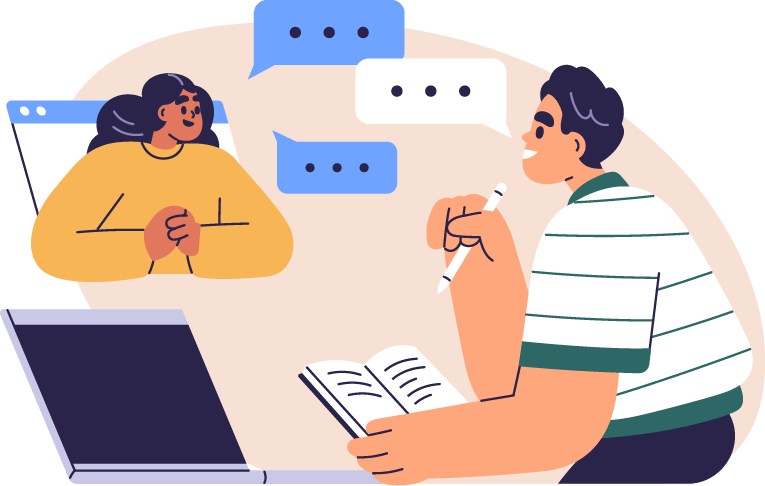
Procedure:
- A list of paired associates is created, where the first word is the stimulus and the second word is the response.
- The pairs can be from the same or different languages.
- For instance, the list could have pairs like a nonsense syllable (e.g., "GEN") and an English noun (e.g., "LOOT").
- The learner sees both words together and must recall the response after seeing the stimulus.
- Learning trials continue until the participant can recall all response terms correctly without mistakes.
- Measure of Learning: The total number of trials needed to reach the goal serves as the measure of paired-associates learning.
2. Serial Learning
This method investigates how participants learn and recall lists of verbal items in a specific sequence.
Procedure:
- Lists of items (nonsense syllables, familiar words, etc.) are prepared.
- Participants are presented with the entire list and required to recall the items in the exact order.
- The process involves showing the first item and requiring the participant to produce the second item. If they fail, the correct item is given, becoming the stimulus for the next item.
- This is called the serial anticipation method.
- Learning trials continue until the participant can correctly anticipate all items in the given order.
3. Free Recall
This method examines how participants recall words from a list in any order.
Procedure:
- Participants are presented with a list of words, which they read and then recall in any order.
- Words may be related or unrelated.
- More than ten words are usually included in the list, and the presentation order varies from trial to trial.
- This method is used to study how participants organize words for memory storage.
- Findings: Items at the beginning or end of the list are recalled more easily than those in the middle, known as the serial position effect.
Determinants of Verbal Learning
Verbal learning has been studied extensively, and researchers have found that several factors affect how we learn verbally. The key factors include the characteristics of what we are trying to learn, such as the length of the list and how meaningful the materials are.
The meaningfulness of material is assessed in several ways, including:
- The number of associations made in a certain time frame.
- The familiarity and frequency of the material's use.
- The relationships among the words in the list.
- The dependency of each word in the list on the preceding words.
Learning time increases as the length of the list grows.
Generalizations:
- Total Time Principle: A fixed amount of time is necessary to learn a fixed amount of material, regardless of the number of trials.
- Organization in Free Recall: In free recall, participants often organize words in a new order or sequence rather than the order of presentation. This is known as category clustering, where words from the same category are recalled together.
- Intentional vs. Incidental Learning: Verbal learning can be intentional or incidental. Participants may notice features like rhyming, starting letters, or vowel similarities unintentionally.
Skill Learning
Nature of Skills
- A skill is the ability to perform complex tasks smoothly and effectively, acquired through practice.
- Examples of skills include driving, piloting, navigating, shorthand writing, and reading.
- Performing a skill involves connecting stimulus-response (S-R) chains into larger patterns, progressing through cognitive, associative, and autonomous phases.
Phases of Skill Acquisition
- Skill learning involves several distinct phases.
- Performance improves with each attempt, becoming more automatic.
- Transitions between phases include performance plateaus and improvements.
Cognitive Phase
- In this initial phase, learners understand and memorise instructions.
- Focus is on external cues, the demands of the instructions, and the outcomes of responses.
Associative Phase
- During this phase, sensory inputs are linked with the correct responses.
- Errors decrease, performance improves, and the time taken to respond is reduced with practice.
Autonomous Phase
- In the final phase, the need for attention decreases, and there is less external interference.
- Performance becomes automatic, requiring minimal conscious effort.
Practice is emphasised as the key to skill learning. Improvement and automaticity come with continued exercise and practice.
Factors Facilitating Learning
In the previous section, we discussed important factors such as the timing of presenting conditioned and unconditioned stimuli in classical conditioning, aspects of reinforcement in operant conditioning, characteristics of models in observational learning, learning processes in verbal learning, and perceptual features in concept learning. The main types of learning include: classical conditioning, operant conditioning, observational learning, cognitive learning, verbal learning, and skill learning. This discussion is not exhaustive; it highlights only some key factors that are very important.
Continuous vs Partial Reinforcement
- Continuous Reinforcement: This type offers reinforcement after every desired response, which leads to high response rates. However, if reinforcement stops, the response rates can drop quickly, and responses learned this way may fade away. As the organism receives reinforcement each time, the impact of that reinforcer may lessen.
- Partial Reinforcement: In this case, only some responses are reinforced, known as partial reinforcement. This method tends to provide greater resistance to fading than continuous reinforcement.
Types of Reinforcement: Reinforcement can be positive or negative. Positive reinforcement includes stimuli that have pleasant outcomes, supporting and maintaining the responses that caused them. Negative reinforcement involves unpleasant stimuli that lead organisms to avoid or escape them, thus encouraging learning of avoidance and escape behaviours.
Delayed Reinforcement: The timing of reinforcement significantly impacts its effectiveness. A delay in reinforcement usually results in lower performance levels. For instance, children often prefer smaller immediate rewards after finishing a task rather than waiting for a larger reward later.
Motivation: The more motivated you are, the more effort you will put into learning. Motivation is essential for learning, as it drives individuals to achieve their goals until their needs are met.
Preparedness for Learning: Different species have distinct sensory capabilities and learning abilities. This means an organism can only learn associations it is genetically prepared for, with varying levels of difficulty across species.
Learning Disabilities
- Learning disability is a broad term that encompasses a diverse range of disorders that lead to challenges in acquiring skills related to reading, writing, speaking, reasoning, and mathematics. These difficulties are inherent in the child.
- The root cause of learning disabilities can be traced back to issues in the central nervous system, and they can occur in combination with physical disabilities, sensory impairments, or intellectual disabilities, or without any of these.
- It is possible to treat learning disabilities.
Symptoms of learning disability
- Children with learning disabilities often struggle with writing letters, words, and phrases. They may also have trouble reading aloud and speaking clearly. Listening problems can occur, even when there are no hearing issues. These children tend to develop learning strategies and plans differently from others.
- Attention issues are common among learning-disabled children. They can become easily distracted and find it hard to focus on one task for long periods. Often, this lack of focus leads to hyperactivity, causing them to be constantly moving and engaging in various activities.
- Many of these children have difficulty with spatial awareness and time management. They may struggle to adjust to new environments, often getting lost. Their understanding of time can be poor, resulting in being late or too early for activities. They can also confuse directions and have trouble distinguishing right from left or up from down.
- Poor motor skills and hand-eye coordination are typical symptoms. This may show in difficulties with balance, using a pencil, opening doors, or learning to ride a bicycle.
- Learning-disabled children often do not follow oral instructions well.
- They can misunderstand social cues, struggling to identify which classmates are friendly or indifferent. Additionally, they may fail to interpret body language.
- Perceptual disorders are frequently seen in these children. This includes challenges with visual, auditory, tactile, and kinesthetic perception. For example, they might confuse a doorbell with a telephone ringing. Their sensory abilities are intact, but they struggle to apply them effectively.
- A significant number of learning-disabled children experience dyslexia. They often have trouble copying letters and words, misreading similar-looking characters like b and d, p and q, or distinguishing between was and saw. They may also find it hard to organise verbal information.
It is important to note that learning disabilities are not permanent. Remedial teaching strategies can greatly assist these children in learning and achieving similar outcomes to their peers. Learning disabilities can occur alongside physical challenges, sensory impairments, or intellectual disabilities, or they can exist independently. They can be observed as specific challenges in children with average to high intelligence.
|
43 videos|88 docs|18 tests
|
FAQs on Learning Class 11 Psychology
| 1. What is the nature of learning and how does it occur? |  |
| 2. How do classical conditioning and operant conditioning differ? |  |
| 3. What is generalization and discrimination in the context of learning? |  |
| 4. How does observational learning differ from cognitive learning? |  |
| 5. What are some methods used in studying verbal learning? |  |

















